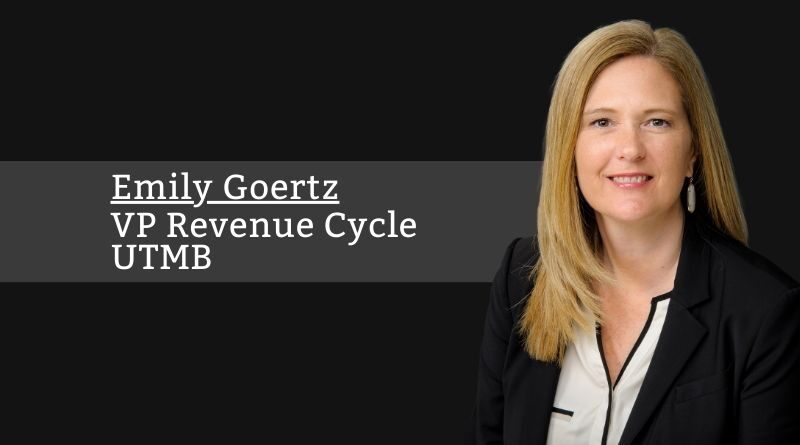Revenue Cycle’s Impact on the Patient Experience
By Emily Goertz, VP of Revenue Cycle, UTMB
Hospital margins are thin if any at all. After this last year with the ongoing pandemic, hospitals and health systems have seen an erosion in their operating margins. Unfortunately, outpatient volumes have fallen short due to patients delaying care or avoiding non-emergent care. Expenses are not the same. Staffing shortages and supply chain challenges are real, and it has created the perfect storm for healthcare providers across the nation.
Without an increase in volumes, health systems look to their revenue cycle department for improvements in net patient care revenue on existing business and volumes. Where are we missing the mark the most in healthcare? In the mid-revenue cycle. All of us in healthcare, and yes, that includes the payers, are responsible for reducing the cost of healthcare. Yet, we seem to have to keep increasing our costs to maneuver the differing payer requirements, ongoing and unnecessary denials, and complexity in getting services authorized and ultimately paid. This challenge is complex and not easily solvable due to the various players and the current environment of healthcare administration. This will likely take legislation, much like the pricing transparency requirements, to solve, as payers are unwilling to reduce the administrative burden placed on health systems to ensure payment for medically necessary services rendered to their members.
The next challenge and area of opportunity is in addressing and improving the patient’s financial experience and solving healthcare affordability. Many improvements have been made due to legislation such as No Surprise Billing, but we are not there yet. Regulatory requirements attempt to address patient pricing requires both payers and providers to post “rates”. However, most patients do not understand healthcare finance well enough to wade through all the data posted and ultimately understand how much an insured patient will owe for their visit. Not only do patients want to know how much they will owe, but they also want patient-friendly solutions that don’t end up in aggressive collection tactics. Estimates are important. Worse than not providing an estimate to a patient is providing one that is not accurate and then billing the balance to the patient. However, to get an accurate patient estimate, you must know exactly what will be performed during the visit. Outside of an office visit, orders are not always accurate or complete to get the estimate right. Many times, treatment decisions are made the same day as the office visit. Providers are not aware of the front-end financial piece that goes along with those decisions, especially in large, complex, integrated delivery systems.
By using a patient financing vendor, healthcare providers can offer their patients flexible payment plans that can be created by scanning a QR code from their statement, a text link (based on a balance file), or a link in MyChart.
One investment that organizations should make is in improving the patient’s financial experience. Providers should offer more payment flexibility for the insured, the under-insured, and uninsured patients. Patients should be able to create easy, flexible, non-interest-bearing payment plans and get the care they need when they need it. Payment plans are difficult to manage internally. Utilizing products outside of the host system for optimization often offers more functionality and flexibility. By using a patient financing vendor, healthcare providers can offer their patients flexible payment plans that can be created by scanning a QR code from their statement, a text link (based on a balance file), or a link in MyChart. This allows the patient to create flexible, interest-free payment plans based on their terms with ease, and even from their smartphone. The patient can pick their payment and the term length of their payment plan; they can add new balances and even skip a payment if needed. The flexibility and self-service option are a value add for all patients and not something that has been easily managed in host patient accounting systems. Once a payment plan is created and the first payment is made, the organization is paid the entire balance minus a fee. Cash comes in faster and no need to send to an early-out vendor or eventually to bad debt. Cash acceleration and reduced bad debt are a win for any organization. There is also the ability to issue a “credit card” specific to your organization that a patient can use for larger balances due at the time of service. This will come in handy for patients seeking non-covered services or outpatient procedures that require payment of a higher deductible and/or co-insurance. If the card is used, the organization gets paid up-front, and the vendor manages the zero-interest payment plan in a consumer-friendly manner. Whichever way a patient decides to create their payment plan, there are no additional fees or interest for the patient and it can all be completed easily from a mobile phone.
This is a big step in the journey to improve the patient’s financial experience, one of the biggest organizational challenges for many health systems across the nation. Patients want to understand what they will owe prior to scheduling service and they want flexibility in paying those balances. Considering the current state that both patients and providers are in, this is one of the best solutions that addresses pain points for both and increases cash for the organization.
There are many opportunities and options to ensure that your organization is capturing every dollar and getting reimbursement for those services, but the patient should always come first. As such, projects that address the patient’s financial experience should be prioritized. A patient financing program will also positively impact an organization’s competitive position in the market.



